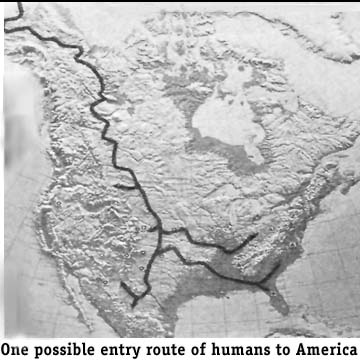|
PREHISTORIC
By Jerry Wilkinson |
 |
|
PREHISTORIC
By Jerry Wilkinson |
 |
|
History is the story of humankind. Its value is that it teaches us what
humans have done and thus what humans are. When one thinks of ancient
history,
one usually conjures up early Europe, Africa or Asia. For the United
States
the specific time is debatable. However, sometime around 110,000 years
ago another Ice Age began (The Wisconsin Ice Age) causing sea levels to
drop about 400 feet is some parts of the world. During part or all of the low water period, there was an apparent migration of humans across a then present land bridge. By way of this land bridge, or causeway (Beringia), from Asia (Siberia) across the Bering Strait to Alaska, human hunter-gatherers migrated to North America and kept moving on for 'greener pastures.' See the above map for one possible route. There is little doubt that the hunter-gatherers brought many domestic animals, some botanical species, tools, hunting implements, etc. with them. Instead of the saying 'Go west' it was 'Go east.' The Beringia land mass lasted from about 47,000 to 14,000 years ago, so a small unofficial trade route could have been established - we do not know. That was about 33,000 years which was a long time relative to counting years at 2009. Archaeologists divide time into periods which I will follow below. Paleo-Indian Period (10,000 b.c. to 8,000 b.c.) - It is thought to have been about 3,000 years later (10,000 BC) before any of these early Paleo-people arrived in North Florida. This would have been at a low water period and Florida would have been about twice as large as it is today because the sea level would have been about 25 to 35 feet lower than today. The additional land mass would have been all of the Florida Bay and a significant part of the Gulf of Mexico. With the rising sea waters the Paleo-Indian's food supply evolved from large animals as bisons, mammoths, etc. to the surviving species of rabbit, deer and marine life. I say thought, as there is some evidence for a theory that the South Florida and the West Indies islands' Paleo-Indians may have migrated here from South America. The reverse could also be true. The West Indies could have been settled by Paleo-Indians traveling by way of Florida. The distant islands of the Pacific and Atlantic oceans became populated in some manner. If not by water travel, then how? If the aborigines could have traveled these distant island routes, they could have easily traveled to the Florida Keys also. If they did, they probably lived near the seashore for a food source, which would have then been along the present-day outer reef. Their village sites would now be under water. In November 2002, Mel Fisher under-water archaeologists found an underwater forest near the site of of the Henrietta Maria slave ship about 35 miles off of Key West. It appears to be a burned forest of prehistoric pine land and radiocarbon cones and wood were dated as 8,400 years old. Albeit no human remains have been found, it does indicate that a habitat was available had humans been there. I predict more evidence will be discovered where there is sand to cover the artifacts. The inhabitation by the Mayas has not been ruled out. There is more to be learned than is known. However, the generally accepted migration route for the Keys' Indians is from the north. For Keys Geology click - HERE. Archaic Period (8,000 b.c. to 750 b.c.) - By this period the sea levels were rising rapidly. The climate changed along with change in sea level and and the land mass was rapidly diminishing. Archaeologists have recently announced that they have carbon dated the remains of Indian brain tissue unearthed at Windover Farms outside of Titusville, Florida. The samples ranged between 5,000 BC and 6,150 BC. Any Indian villages in the Florida Keys of the same time period the sea level would be about 25 to 10 feet lower than today. This could explain why no archaic Indian sites have been dated in the Keys. These sites indicated the increased reliance on marine live for food and tools. Cooking utensils and tools make dating of this period more specific. Sometime around 4,000 years ago (2,000 BC), a seemingly independent invention of "pottery making" happened in the Florida-Georgia area. Early Venezuelan and island pottery are both dated later. Shredded materials such as palmetto fibers, Spanish moss and other grasses were used to reinforce and hold the clay together, known as temper. This is important because if sand-fired pottery fragments are found, the site is younger than this. Weapons were made of sharks' teeth, stingray barbs, billfish bills, et cetera. Eating utensils were made from coconuts, various sized shells, bones and other materials. This time is called the "Stone Age" for most of the world, but it was the "Shell Age" for the Keys. There were no stones so shells were used for various weapons, utensils and tools. Archaeologists noted another change around 1,000 BC. The pottery became rounded and the decorations were changed. Burial grounds started to be used. Some believe this was influenced by the migration of new groups from Mexico. This is the general time period when we believe they first permanently settled the Keys in large groups. Glades Period (750 b.c. to a.d 1500) - This period is divided into three periods - I, II, and III. Pottery types characterize the different periods, but there are associated types of tools. By 500 BC, the tradition of adding fibers to temper the clay was largely replaced by the addition of grit, sand, shell and limestone, much as is done today. This is another important date stamp. However, they did not have high temperature kilns to glaze the pottery as potters do today. It appears that the Indian societies were not tightly knit enough to be classified as tribes and were classified by anthropologists as "cultures." For example, around this 500-BC era northeast Florida was occupied by the St. Johns culture, which endured for more than 1,000 years before finally evolving into the "Timucuan" tribe just before historic times. Meanwhile, on the west coast, it was primarily the Deptford culture with the related Weeden Island and Fort Walton cultures which, by 500 BC, had spread over most of all western and central Florida. These too, were routed by rival Georgian groups and eventually evolved into the historic Pensacola, Apalachee and Tocobaga tribes. Later, De Soto and Narvaez during their treks through the Southeastern United States encountered these Indians in 1540 and 1528. The Glades culture occupied south Florida, which included the Keys. The Indians who lived along the southern coasts relied more on marine and aquatic items than the more northern groups. On the west coast from Fort Myers to Naples, the Indians of the Glades culture lived on shell mounds and were the predecessors of the Calusa (Caloosa, Calos, or Carlos) Indians. A group on the southeast coast lived at the mouths of rivers and streams and was with little doubt the predecessor of the Tequesta (Tekesta, or Chequesta) Indians in the Miami area. Note the spelling variations of these names. The Everglades and Lake Okeechobee provided a somewhat natural barrier between the historic Calusa and Tequesta, but it is widely believed that they traveled back and forth in canoes. Before all the drainage canals were dug, the water in the Everglades was much deeper. Evidence indicates that these Indians made sea journeys using large catamaran canoes with sails. The hydraulic head pressure of the mainland fresh water sources almost surely would have provided early natives with sufficient drinking water to support life. There are still fresh water wells (solution holes) up and down the Keys, but drainage of mainland Florida has severely lowered the fresh water level and raised the level of salt-water intrusion. There have been four accepted archaeological surveys made in the Upper Keys: Dr. John M. Goggin in 1944-49 and the Archaeological and Historical Conservancy (AHC) in 1985, and local archaeologists Irving Eyster in 1964-5 and Duncan Mathewson in 1990 (continuing to the present). Through lack of interest, and/or funding nothing scientifically conclusive has appeared to date; however, the sites are here and identified. The 1985 AHC report is fairly comprehensive, but encompasses Key Largo only. The Florida Master Site File lists all that have been officially identified. Many local historical and architectural sites have yet been submitted. Perhaps some day they will be.
There is one village site on north Key Largo thought to date back to
1,600
BC, based upon pottery evaluations. Scattered small excavations in the
Upper Keys' kitchen middens seem to indicate that they are circa 500 to
700 AD. These are usually attributed to the Matecumbe group, of which
little
has been scientifically established. The early Spanish travelers
frequently
mentioned the Matecumbes. Historic Contact Period (a.d. 1500 to a.d. 1750) - This is the period where written accounts begin to appear; albeit, the writings of the the Europeans. Written accounts of Ponce de Leon, Hernando Fonteneda, etc. have been translated for everyone to read. There are writing of contact made with Calusa and Tequesta mainly by the Spanish during this period; albeit, the French and English had contact. Most agree that around the time of English ownership of Florida in 1763 the population of indigenous Florida Native Americans were either dead or had migrated to Cuba. Historic Period (a.d 1750 to present) - White settlers were becoming more interested in Florida. At the same time Creek Indians were being driven westward and independent bands of the Creek Nation found their way southward to Florida. A favorite mode of transportation were the many rivers that flowed southward and these Neo-Florida Indians became the Seminole.
It should be mentioned that no gold or silver has ever been found in
these terrestrial archaeological sites, so should you discover a site,
please do not
disturb
them. Please leave them until funding and/or technology exist to
unravel
the mysteries. Most libraries can assist you in finding a list of
archeological sites. Our site designations begin with the letters "MO"
meaning Monroe County. -----End------- Return to General Keys History |
